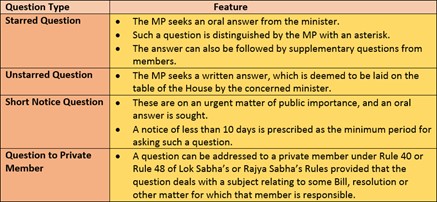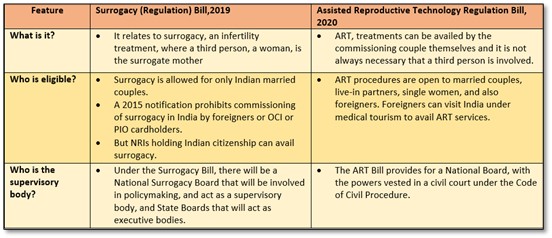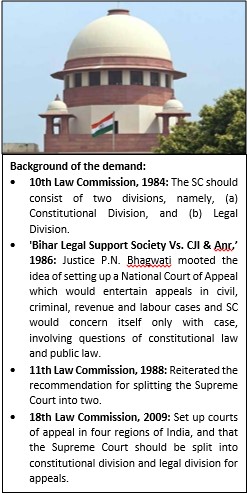Tuesday, 7th December 2021
Judicial Infrastructure in India
In News
The Chief Justice of India has recommended the National Judicial Infrastructure Authority of India (NJIAI).
State of Judicial Infrastructure in India
- Underutilized Funds: Out of the total funds sanctioned in 2019-20 under the Centrally Sponsored Scheme (CSS) to the States and UTs for development of infrastructure in the courts, only around 9% was utilised by a combined five States, rendering the remaining 91.36% funds unused.
- Infrastructure vs Litigation: The Indian judiciary’s infrastructure has not kept pace with the sheer number of litigations instituted every year. The total sanctioned strength of judicial officers in the country is 24,280, but the number of court halls available is just 20,143, including 620 rented halls.
- Lack of basic amenities: As much as 26% of the court complexes do not have separate ladies toilets and 16% do not have gents toilets. Only 32% of the courtrooms have separate record rooms and only 51% of the court complexes have a library.
- Skewed Digital Infra: While the pandemic has forced most of the courts to adopt a hybrid system- physical and videoconferencing mode of hearing, only 27% of the courtrooms have a computer placed on the judge’s dais with videoconferencing facility.
- Ad-hoc and Unplanned Maintenance: Improvement and maintenance of judicial infrastructure is being carried out in an ad-hoc and unplanned manner.
- Therefore there is a need for “financial autonomy of the judiciary” and hence creation of the NJIAI is highly recommended as it will work as a central agency with a degree of autonomy.
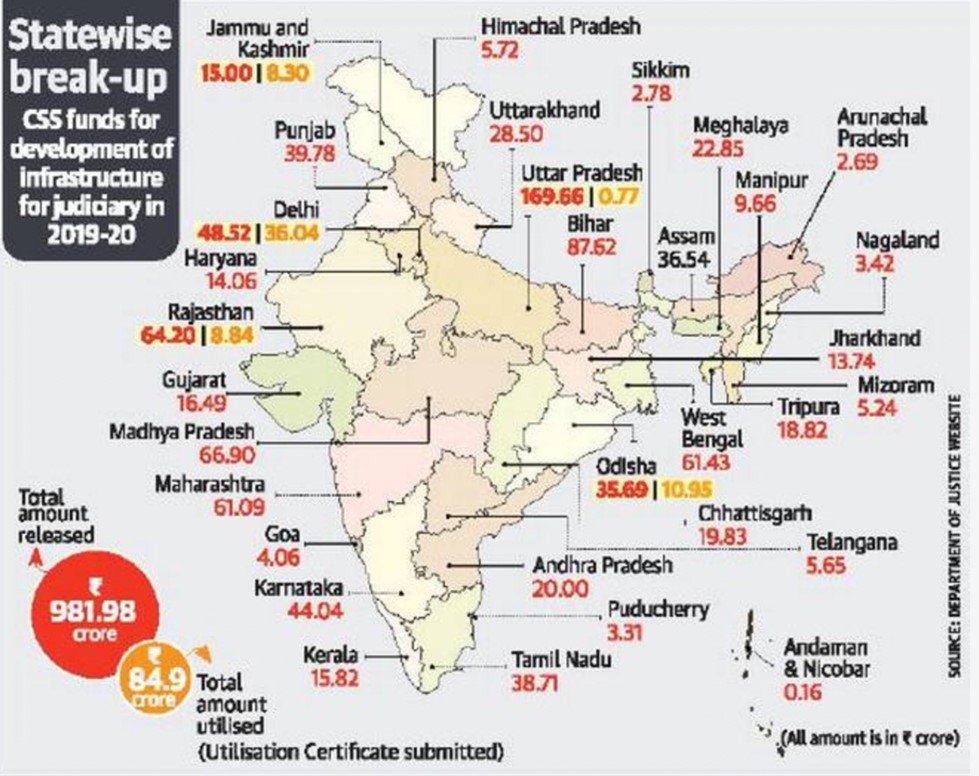
The Proposed Structure of the NJIAI
- NJIAI could work as a central agency with each State having its own State Judicial Infrastructure Authority, much like the National Legal Services Authority (NALSA) model.
- It has been suggested that the Chief Justice of India could be the patron-in-chief of the NJIAI, like in NALSA, and one of the Supreme Court judges nominated by the Chief Justice could be the executive chairman.
- Exception:
- But, unlike NALSA which is serviced by the Ministry of Law and Justice, the proposed NJIAI should be placed under the Supreme Court of India.
- In the NJIAI there could be a few High Court judges as members, and some Central Government officials because the Centre must also know where the funds are being utilised.
- In the State Judicial Infrastructure Authority, in addition to the Chief Justice of the respective High Court and a nominated judge, four to five district court judges and State Government officials could be members
Where can it be used?
- Judicial Infrastructure, Judicial reforms
Source:
- Judicial infrastructure, a neglected case
- Judicial Infrastructure
- CJI N V Ramana sends proposal to set up National Judicial Infrastructure Authority of India
Image Source:
Bad Banks for Farm loans
In News
In an attempt to improve recovery of bad loans in the agriculture sector, Asset Reconstruction Company for farm loans has been proposed by Banks.
Need for Bad Banks for the Farm Sector
- At one end, farmers are struggling to get bank loans, as formal sector lenders have become even more risk averse amid the pandemic. At another, banks are challenged by huge non-performing assets (NPAs) as they’re unable to recover farm loans. An ARC would be able to bridge this gap.
- Bank NPAs from agriculture have shot up by at least 23% in a year, from 3 per cent in 2017.
- As per RBI, Bad loans (gross non-performing assets) for the agricultural sector stood at 8 per cent at the end of March 2021.
- Considering the absence of a unified framework to deal with the enforcement of mortgages created on agricultural land, there is a need for creating an effective mechanism for the recovery of dues.
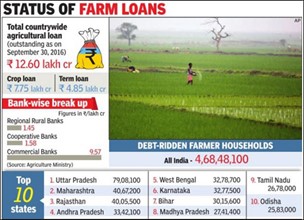
What can be the possible Challenges to ARC for Farm Sector?
- Nascent stage: Framework for the resolution of corporate sector bad loans haven’t been able to show effectiveness of this architecture.
- Limited outreach: Banks have far greater presence on the ground than a single ARC, they are likely to be more capable of navigating the local terrain to recover their dues.
- Local bank officials may be more successful in dealing with hundreds and thousands of these small borrowers than a single ARC.
- Poor land records: Rural land markets are characterised by lack of clear titles and multiple stakeholders. This is a complex structure and nor comparable to ARCs operating in the corporate loan market. Recovery will prove to be difficult.
- Constitutional position: Since agriculture is a State subject, each State has a different set of laws governing the recovery of loans taken with farm land as the collateral. This means banks cannot have uniform laws for all their farmer-customers, which makes recovery very difficult.
- Political risk: Even though land is a mortgageable asset, it is an emotive, political issue.
- Election Cycle: Loan waivers and subsidies in the Farm sector make it difficult to recover bad loans.

Where can it be used?
- Farm Sector NPA, ARC for Farm Sector
Sources:
India- Russia 2+2 meeting
In News
Recently, a 2+2 meeting was held between Indian and Russian Defence and Foreign Ministers where the two countries inked 28 pacts.
Important pacts signed
- The two countries signed a contract worth Rs 5,000 crore for the manufacture of nearly 6 lakh AK-203 rifles, under a joint venture in Amethi, Uttar Pradesh.
- The two countries also signed an agreement for military technology cooperation for the next decade — from 2021 to 2031.
- In all, 9 government-to-government agreements that spanned areas of defence, space, finance, power, culture, scientific research, education and health among others. 19 others were commercial pacts in an array of areas.
- The two sides could not conclude the Reciprocal Logistics Support Agreement (RELOS) since there were some issues pending with it.
- Russia has also begun deliveries of the S-400 long range air defence systems, the shipments of which are en-route.
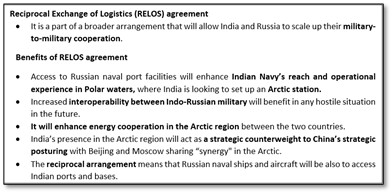
Other important issues discussed
- On Afghanistan Issue: Both the parties have outlined priorities which include ensuring formation of a truly inclusive and representative government in Afghanistan, combating terrorism and drug trafficking, providing immediate humanitarian assistance and preserving the rights of women, children and minorities.
- COVID Vaccination: Both sides agreed to fast track the formalities at early mutual recognition of Covid vaccination certificates to further facilitate the movement of persons between the two countries.
- Make-In-India and Joint manufacturing: Both sides agreed to take forward ongoing engagements to encourage joint manufacturing in India of spare parts, components, aggregates and other products for maintenance of Russian-origin arms and defence equipment under Make-in-India program through transfer of technology and setting up of joint ventures.
Where can it be used?
- IR, India-Russia, 2+2
Sources:
International Civil Aviation Day
On December 7, 1996 International Civil Aviation Day was formally established by the United Nations General Assembly (UNGA). International Civil Aviation Day is an annual UN observation day held on December 7 in order to recognize the socio-economic and development importance of aviation and international air travel. Additionally, it acknowledges the unique role played by the International Civil Aviation Organization (ICAO) in providing global aviation safety, efficiency, and uniformity. The day was first observed in 1994 as part of ICAO’s 50th anniversary. International Civil Aviation Day is marked every five years by the ICAO with a special anniversary theme. Each of these anniversary years is marked by a single theme that runs for the full four-year interval between them. From now until 2023, the council has decided upon the theme: “Advancing Innovation for Global Aviation Development.”
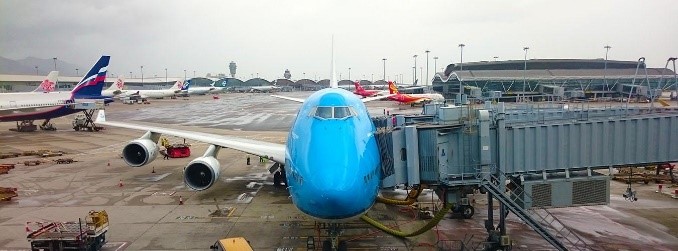
Source:
RBI Review of the Working of ARC
In News
A Committee, headed by Sudarshan Sen, to Review the Working of Asset Reconstruction Companies (ARC) has proposed several reforms to streamline the functioning of ARCs.
History of ARC in India
- Indian banking system has often dealt with high levels of NPAs which affects the profitability and eventually the capital position of banks, especially the public sector banks (PSBs), leading to risk aversion among the banks and deceleration of credit growth in the country.
- The Financial Stability Report of July 2021 indicates that the GNPA ratio of Scheduled Commercial Banks s may transition to 9.80% in the baseline scenario by March 2022 and may increase to 10.36% and 11.22% under the other stress scenarios.
- In view of its importance for the health of the banking system, management of NPAs has been under focus of the RBI and the Government of India (GoI). Several legal and regulatory measures have been developed to address the issue over the years.
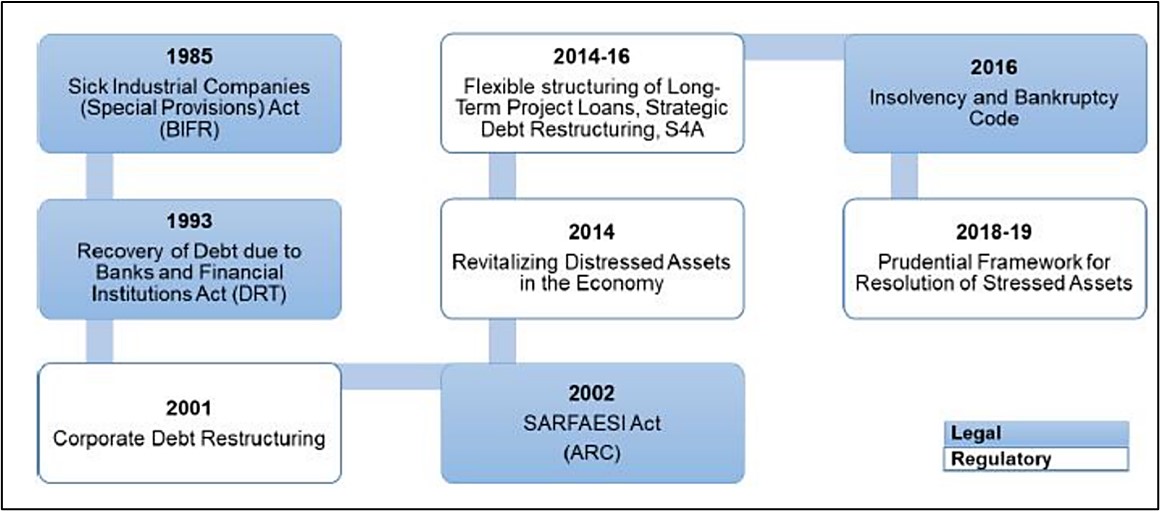
- Debt Recovery Tribunals (DRTs) established under RDDBFI Act 1993, were special tribunals to deal with loan recovery. As the rate of recovery due to DRTs dropped over the years, the need was felt to set up ARCs, as recommended by the Narasimham committee-II or the Banking Sector Reforms Committee.
- Hence, the SARFAESI Act was passed in 2002 and it paved the way for setting up ARCs in India.
- Asset Reconstruction Company (India) Ltd set up in 2002 by four banks: SBI, ICICI Bank, PNB and IDBI Bank, was the first ARC in India.
- Currently, there are 28 ARCs in India dealing with resolution of stressed assets. But these deal majorly with smaller value loans.
- Although several resolution mechanisms, including the 2016 Insolvency and Bankruptcy Code (IBC) have been effective, a government-backed ARC has become necessary to resolve the large stock of legacy NPAs of PSBs.
- GoI has recently set up an ARC – National Asset Reconstruction Company Limited (NARCL), referred to as the ‘bad bank’ to consolidate and take over the existing stressed debt or bad loans of PSBs.
Working of an ARC
- An ARC is a special type of financial institution that buys the secured assets of the debtors (Borrower) of the bank at a mutually agreed value and attempts to recover the debts or associated securities by itself.
- The SARFAESI Act empowers ARCs to issue security receipts (SRs) and only qualified buyers (QBs) are permitted to acquire such SRs.
- QBs include a financial institution, insurance company, bank, state financial corporation, state industrial development corporation, ARC or any asset management company (AMC) making investment on behalf of mutual fund or a SEBI registered foreign institutional investor, any category of non-institutional investors as may be specified by RBI or any other body corporate as may be specified by SEBI.
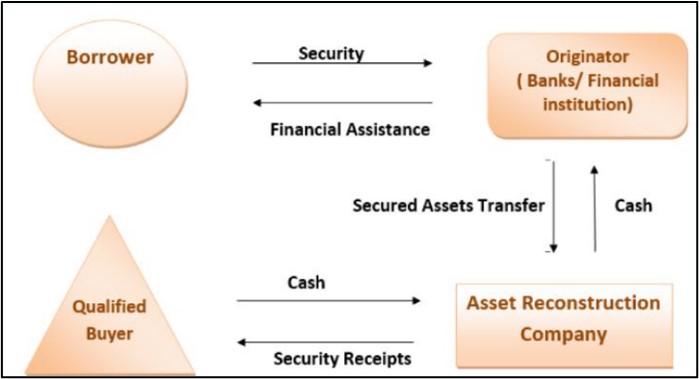
Advantages of ARC
- ARCs allow banks/ FIs to focus on their core function of lending by removing the sticky stressed assets from their books and thereby freeing up their capital and management for productive use.
- Where lenders invest in security receipts (SRs), ARCs make recovery for lenders by acting as the manager of the stressed assets.
- ARCs can help the borrowers in reviving their businesses.
- Investors with their detailed knowledge of the market environment will be more easily able to spot an undervalued product.
Challenges faced by ARCs in India
- While ARCs have been in operation since 2003, their performance in management of stressed assets of banks/ FIs is still uneven on several parameters.
- Banks and other investors could recover only about 14.29 per cent of the amount owed by borrowers in respect of stressed assets sold to ARCs during the 2004-2013 period.
- ARCs’ performance in ensuring revival of businesses has also been poor. ARCs have rarely used methods such as change in or takeover of the management of the business of the borrower or conversion of debt into equity in a borrower’s company or rescheduling of payment of debts.
- Inadequate capital with ARCs and ARCs’ lack of skill sets in turning around borrowers is also part of the problem.
Despite these problems, the ARC model remains relevant as
- A private sector led permanent institutional framework for out-of-court resolution of stressed assets of the financial sector
- It allows investors to hold on to the upside of stressed assets in uncertain times through issuance of security receipts. This has become relevant in recent times.
Some important recommendations of the RBI Committee
The committee has tabled a set of 42 recommendations based on the various aspects of the working of an ARC. Key recommendations are:
- The scope of Section 5 of the SARFAESI Act be expanded to permit ARCs to acquire financial assets from all regulated entities, including Alternative Investment Funds (AIFs), Foreign Portfolio Investors (FPIs), AMCs making investment on behalf of Mutual Funds (MFs) and all Non-Banking Financial Companies (NBFCs) including Housing Finance Companies (HFCs).
- ARCs should be allowed to sponsor a Sebi-registered AIF, to be used as an additional vehicle for facilitating restructuring/ recovery of the debt acquired by the ARC and a meaningful turnaround of the borrower.
- In order to enhance ARCs' ability to be a prime vehicle for resolution, they may be allowed to participate in IBC as a resolution applicant either through their SR trust or through the AIF sponsored by them.
- RBI should ensure fair competition between the NARCL and private ARCs to promote the objectives of true price discovery through the market mechanism.
- Sale of fraud accounts to ARCs may be permitted subject to appropriate safeguards to ensure that fixing of accountability at lender level and criminal inquiry by competent authorities are not affected by this transfer.
Conclusion: A sound banking system is an essential requirement for maintaining financial stability in any country. One of the parameters of soundness is the level of non-performing assets (NPAs) in the banking system. Against the backdrop of significant build-up of non-performing assets (NPAs) in the financial system, asset reconstruction companies (ARCs) are expected to play a critical role. Data shows that the performance of the ARCs has been lacklustre. So, rejuvenating the ARCs can be a game changer for the economy.
Question: Discuss the evolution, working and challenges faced by ARCs in India.
Where can it be used?
- ARC, Bad Bank, NPA, RBI, Economy
Sources:
- Report of the Committee to Review the Working of Asset Reconstruction Companies
- RBI panel makes host of suggestions to streamline functioning of ARCs
- RBI panel calls for an overhaul of ARC regulations
- FAQs regarding NARCL
- ARCs in India: A Study of their Business Operations and Role in NPA Resolution
Semeru volcanic eruption
This is image of the Semeru volcano, which erupted recently, spewing towers of ash and hot clouds. The Semeru volcano is located on the tallest mountain on Java island. At least 13 people have died and dozens were injured after the Semeru volcano in Indonesia erupted. The eruption was accompanied by a thunderstorm and rain, which pushed lava and smoldering debris, and formed thick mud. Situated at a height of over 3,600 metres, Semeru is among the nearly 130 active volcanoes in Indonesia. With a population of over 270 million, the archipelago of Indonesia straddles the Pacific Ring of Fire. It is prone to earthquakes and volcanic activity. An eruption of the Merapi volcano on Java island had killed over 350 people and displaced 4,00,000 back in 2010.
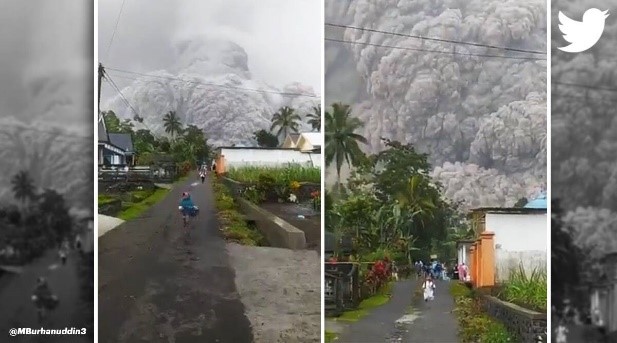
Sources:
Green Energy Corridor Project
- Context: A green energy corridor is being developed for the first time in western Rajasthan.
- The Green Energy Corridor Project aims at synchronizing electricity produced from renewable sources, such as solar, wind, small hydro and tidal with conventional power stations in the grid.
- The project focusses on evacuation of renewable energy from generation points to the load centres by creating intra-state and inter-state transmission
- This is implemented by the State Transmission Utilities of eight renewable resource rich states of Tamil Nadu, Rajasthan, Karnataka, Andhra Pradesh, Maharashtra, Gujarat, Himachal Pradesh, and Madhya Pradesh.
- The project was announced by the Power Grid Corporation of India Ltd. (PGCIL) in the year 2013 to at add all major renewable energy projects in different parts of the country to the national grid by 2030.
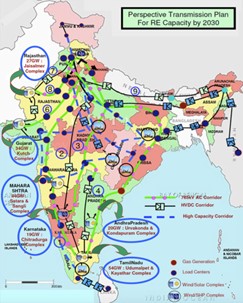
Source:
- What is Green Energy corridor project?
- First green energy corridor being developed in Rajasthan
- Green Energy corridor project
Image Source:
Target Olympic Podium Scheme (TOPS)
- Context: Olympic legends from India have been tasked to steer 2024 Paris Olympics preparation through (TOPS).
- These include Anjali Bhagwat from Shooting, badminton ace Trupti Murgunde, hockey skipper Viren Rasquinha, and table tennis star Monalisa Mehta
- TOPS is a flagship program of the Ministry of Youth Affairs and Sports to provide assistance to India’s top athletes.
- The Scheme looks to add a premium to the preparations of these athletes so that they can win medals in the Olympics.
- The Scheme currently supports 104 TOPS Core Group athletes across 13 sports disciplines & Hockey (M & W) teams and 269 TOPS Development Group athletes across 12 sports disciplines.
- It was launched in 2014 in order to improve India’s performance at Olympics and Paralympics.
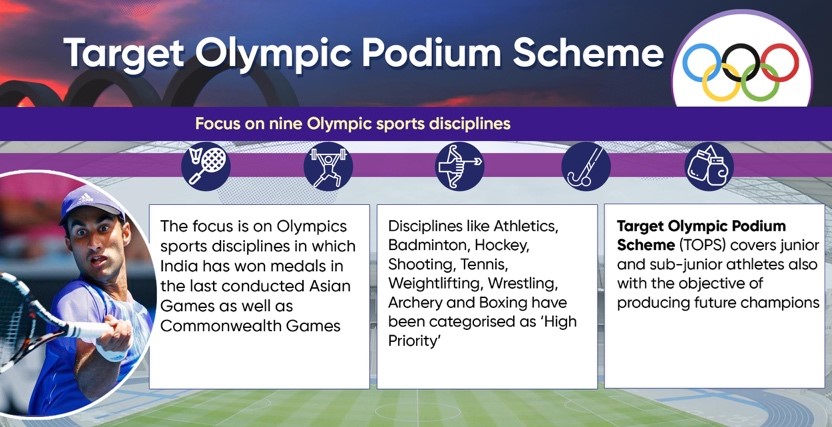
Source
- Bhaichung, Anju Bobby George among 7 new members of Mission Olympic Cell
- Target Olympic Podium Scheme
Image Source:
IFFCO
- Context: The Indian Farmers Fertilizer Cooperative Limited (IFFCO) has been ranked 'number one Cooperative' among the top 300 cooperatives in the world, withholding its position from last year.
- IFFCO is one of India's biggest cooperative society which is wholly owned by Indian Cooperatives.
- It was founded in 1967 with just 57 cooperatives. Today it is an amalgamation of over 36,000 Indian Cooperatives with diversified business interests ranging from General Insurance to Rural Telecom apart from its core business of manufacturing and selling fertilisers.
- Its objectives include:
- To augment the incremental incomes of farmers by helping them to increase their crop productivity through the balanced use of energy efficient fertilisers;
- maintain the environmental health; and
- make cooperative societies economically and democratically strong for professionalised services to the farming community to ensure an empowered rural India.

Source:
Image Source:
World’s Most Expensive City
- Context: The Worldwide Cost of Living Index released by the Economist Intelligence Unit (EIU) has listed the world’s most expensive cities to live in 2021.
- The index explores the cost of living in 173 cities, measured against impactful global events.
- It is benchmarked against the prices of 200 everyday products and services in New York, meaning that the countries with currency stronger than the US dollar will appear higher on the list.
- Observations:
- Tel Aviv, a city in Israel, has topped of the list. Its ranking on the list is attributed to its national currency, Shekel’s strength against the US dollar, and increases in grocery and transport prices.
- European and developed Asian cities continue to occupy the top rankings while those on the lower ranks consist of Middle Eastern, African and lesser developed parts of Asia.
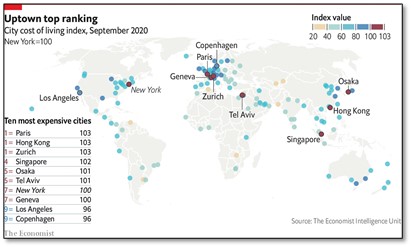
Source:
- The world’s most expensive city to live in is…
- Worldwide Cost of Living 2021: explore the rise and fall of living costs in 173 cities
Image Source:
The way to tackle malnutrition: TH
Essence: It is disappointing to note that the National Health Family Survey (NHFS 5) shows negligible nutritional outcomes among under 5 children. While we need monitoring of data for programmatic evaluation and correction, but the larger question is if that data is enough for helping starving children. Here comes the role of Planning based on data for better governance.
The article has suggested some steps at the cutting edge like monitoring by Anganwadi workers and Asha workers and take home ration for under 3 as per ICDS. The article has also emphasized on monitoring of the Public Distribution System (PDS) and augmenting of the PDS with programs such as Poshan Abhiyan, MGNREGA avert malnutrition, not just starvation. There is need for s a healthy new generation and ensure proper nutrition and growth.
Why to read this article?
- To know what NHFS 5 data reveals about nutritional outcome, undernutrition, wasting and stunting.
- To understand that process of monitoring nutrition should get importance over survey outcomes to fight malnutrition and what should be our way forward in this direction.
- Malnutrition (GS II) becomes an important issue due to the data of NHFS 5 which shows negligible gains in nutritional outcome despite government efforts.
Source:
India’s race to quantum supremacy: ORF
Essence: The article talks about the benefits of quantum technology and the developments by different countries in this area. India also joined the race of Quantum computing by establishing the National Mission for Quantum Technology and Applications (NM-QTA) in 2020. However, to be frontrunner, India needs to work on its quantum ecosystem. Lack of skilled professionals along with unavailability of appropriate hardware is keeping India from achieving its full potential.
To ensure that India emerges as world leader it should acknowledge the policy-level and implementation-level gaps and work on it in a timely manner. For this. India should give a boost to its investor ecosystem along with working on bridging the skill gap. Over and above, India needs to give impetus to its semiconductor industry and amplify the production of hardware components to support the development of quantum technology in the country.
Why you should read this article?
- To understand different dimensions of quantum technology in India.
- To understand the benefits that the quantum technology serves.
- To understand the gaps that is stopping India from realizing India its full potential and the steps India should take.
- The article provides a comprehensive coverage on the topic Quantum Technology. (GS-3, Science and Technology)
Source:
The supply chain hurdle in India’s recovery: HBL
Essence: The article talks about another crisis that is stalking the world — supply chain bottlenecks. India also faced the heart of it in the form of higher prices for the commodities. As the Indian economy shows signs of recovery around 2022 paucity or delays in availability of raw material could delays India’s recovery.
As India’s import have been rising consistently, especially in energy sector, it should first secure its energy supplies in short run and in long term should focus on building its own manufacturing facilities. As the level of integration in supply chain became quite evident, it is high time India should aim at building resilient supply chain which will allow India’s export to grow.
Why you should read this article?
- To understand how the bottlenecks in supply chain can be disruptive for the world economy.
- To understand the effects of bottlenecks on Indian economy.
Source:
Meet The Clothing Man of India!
Background story
- Anshu Gupta, the founder of NGO Goonj, was moved by the basic need of clothing, an issue that does not have a place in the development agenda.
- Using cloth as starting point for other crucial yet ignored needs like sanitary pads, school material for education, Goonj started to contribute to India’s re-growth with the help of urban waste.

Cloth for work initiative
- He felt that charity deprives the people of self-respect and hence, he introduced the concept of "cloth for work".
- Villagers work to dig wells, clean ponds, repair roads, and build schools in the community using local resources, for which they were compensated with material resources like clothing, utensils, furniture, and food grains.
- Later, the program was renamed as “Dignity for work”.
Where can this case study be used:
- Dedication towards society, Community service, Initiative taking ability.
Quote:
- The best way to find yourself is to lose yourself in the service of others. (Gandhi ji)
Source:
Share the article
Get Latest Updates on Offers, Event dates, and free Mentorship sessions.

Get in touch with our Expert Academic Counsellors 👋
Frequently Asked Questions
UPSC Daily Current Affairs focuses on learning current events on a daily basis. An aspirant needs to study regular and updated information about current events, news, and relevant topics that are important for UPSC aspirants. It covers national and international affairs, government policies, socio-economic issues, science and technology advancements, and more.
UPSC Daily Current Affairs provides aspirants with a concise and comprehensive overview of the latest happenings and developments across various fields. It helps aspirants stay updated with current affairs and provides them with valuable insights and analysis, which are essential for answering questions in the UPSC examinations. It enhances their knowledge, analytical skills, and ability to connect current affairs with the UPSC syllabus.
UPSC Daily Current Affairs covers a wide range of topics, including politics, economics, science and technology, environment, social issues, governance, international relations, and more. It offers news summaries, in-depth analyses, editorials, opinion pieces, and relevant study materials. It also provides practice questions and quizzes to help aspirants test their understanding of current affairs.
Edukemy's UPSC Daily Current Affairs can be accessed through:
- UPSC Daily Current Affairs can be accessed through Current Affairs tab at the top of the Main Page of Edukemy.
- Edukemy Mobile app: The Daily Current Affairs can also be access through Edukemy Mobile App.
- Social media: Follow Edukemy’s official social media accounts or pages that provide UPSC Daily Current Affairs updates, including Facebook, Twitter, or Telegram channels.

